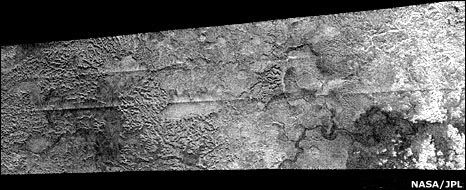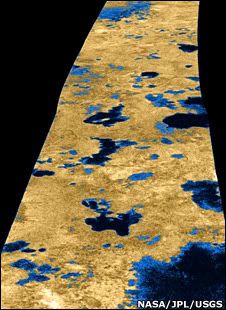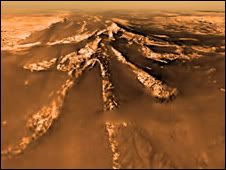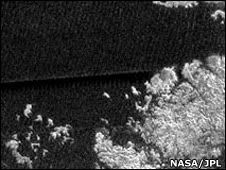
Over 16,530,180 people are on fubar.
What are you waiting for?

 Three views of Titan (Nasa/JPL/SSI)
Three different views of Saturn's largest moon
If worlds have shadow twins elsewhere in the Universe, then Earth's would appear to lie just a block or two down the cosmic road, in orbit around Saturn.
"We have on Titan many of the geological features that we find on Earth," enthuses Rosaly Lopes.
"We find volcanism, we find tectonics, we find erosion and deposition, and wind activity forming dunes.
"It's very similar to the Earth."
But there is a crucial difference: Titan is so cold that most of the water is solid.
This combination of liquid water in the interior plus complex organic molecules composes two big ingredients for life
Ralph Lorenz, Johns Hopkins University
The rivers flowing across these plains are formed of a hydrocarbon soup with methane as its main ingredient.
Three views of Titan (Nasa/JPL/SSI)
Three different views of Saturn's largest moon
If worlds have shadow twins elsewhere in the Universe, then Earth's would appear to lie just a block or two down the cosmic road, in orbit around Saturn.
"We have on Titan many of the geological features that we find on Earth," enthuses Rosaly Lopes.
"We find volcanism, we find tectonics, we find erosion and deposition, and wind activity forming dunes.
"It's very similar to the Earth."
But there is a crucial difference: Titan is so cold that most of the water is solid.
This combination of liquid water in the interior plus complex organic molecules composes two big ingredients for life
Ralph Lorenz, Johns Hopkins University
The rivers flowing across these plains are formed of a hydrocarbon soup with methane as its main ingredient.
 The true nature of this once mysterious world is now finally emerging, courtesy largely of the Cassini-Huygens mission, a joint US-European venture, which deposited a landing craft on Titan, and continues to send back data and pictures of Saturn, its rings and its 60-odd moons.
Dr Lopes, from Nasa's Jet Propulsion Laboratory (JPL) in California, is one of the scientists reviewing the Titan findings at the European Geosciences Union (EGU) meeting in Vienna, Europe's largest annual gathering of scientists studying the Earth, its climate and its cosmic neighbourhood.
Four years after its arrival in the Saturnian system, Cassini is now showing researchers just how similar Titan is to our own planet.
Lake district
Last year, the craft's radar identified large areas close to the moon's north pole that are apparently lakes filled with the same methane-rich liquid. A few have subsequently turned up near the south pole, too.
The true nature of this once mysterious world is now finally emerging, courtesy largely of the Cassini-Huygens mission, a joint US-European venture, which deposited a landing craft on Titan, and continues to send back data and pictures of Saturn, its rings and its 60-odd moons.
Dr Lopes, from Nasa's Jet Propulsion Laboratory (JPL) in California, is one of the scientists reviewing the Titan findings at the European Geosciences Union (EGU) meeting in Vienna, Europe's largest annual gathering of scientists studying the Earth, its climate and its cosmic neighbourhood.
Four years after its arrival in the Saturnian system, Cassini is now showing researchers just how similar Titan is to our own planet.
Lake district
Last year, the craft's radar identified large areas close to the moon's north pole that are apparently lakes filled with the same methane-rich liquid. A few have subsequently turned up near the south pole, too.
 Radar image of lakes on Titan (Nasa/JPL/USGS)
The radar instrument has identified lakes on Titan's surface
"What you have is very much like the hydrological cycle on Earth," explains Sushil Atreya from the University of Michigan in Ann Arbor.
"We have methane lakes in the high latitude regions, and the lower part of the atmosphere is sub-saturated, so there's about 40% relative humidity [of methane].
"And from time to time, it will rain methane onto the surface, which then collects into lakes; and there are also equatorial storms in the tropical regions."
So alike do the lakes appear to those on Earth that the cosmological "nomenclature police", the International Astronomical Union (IAU), have decreed that they can be named after those on our planet.
Among others, Titan now features a Lake Abeya, a Lake Mackay and a Lake Ontario, named because their shapes resemble their terrestrial equivalents in Ethiopia, Australia and Canada.
Long trails
Perhaps the most spectacular example of Titan's mimicry of our terrestrial home lies in the river valleys, which are disturbingly Earth-like - long snaking structures with tributaries arranged like veins on a leaf.
Look at the images really hard, and you can almost imagine zooming in to find some Titanian vegetation growing along the banks, and a train of methane-guzzling animals heading down to drink.
"There are a lot of valley systems, and a few are very huge, in the order of 1,000km long," notes Ralf Jaumann from the German Aerospace Center (DLR).
Radar image of lakes on Titan (Nasa/JPL/USGS)
The radar instrument has identified lakes on Titan's surface
"What you have is very much like the hydrological cycle on Earth," explains Sushil Atreya from the University of Michigan in Ann Arbor.
"We have methane lakes in the high latitude regions, and the lower part of the atmosphere is sub-saturated, so there's about 40% relative humidity [of methane].
"And from time to time, it will rain methane onto the surface, which then collects into lakes; and there are also equatorial storms in the tropical regions."
So alike do the lakes appear to those on Earth that the cosmological "nomenclature police", the International Astronomical Union (IAU), have decreed that they can be named after those on our planet.
Among others, Titan now features a Lake Abeya, a Lake Mackay and a Lake Ontario, named because their shapes resemble their terrestrial equivalents in Ethiopia, Australia and Canada.
Long trails
Perhaps the most spectacular example of Titan's mimicry of our terrestrial home lies in the river valleys, which are disturbingly Earth-like - long snaking structures with tributaries arranged like veins on a leaf.
Look at the images really hard, and you can almost imagine zooming in to find some Titanian vegetation growing along the banks, and a train of methane-guzzling animals heading down to drink.
"There are a lot of valley systems, and a few are very huge, in the order of 1,000km long," notes Ralf Jaumann from the German Aerospace Center (DLR).
 Features resembling river valleys on Titan (Nasa/JPL)
Cassini has seen many valley systems on Titan's surface
"We tried to figure out what these systems are doing with erosion on the surface, and it's comparable with what we know on Earth; these rivers are doing erosion and sediment transport just as we know it from rivers like the Rhine, Elbe and probably the Mississippi. But the liquid in these rivers is not water, but methane."
Ask why methane plays the role here that water plays on Earth, and the answer is disturbingly simple: it is chance.
On Earth, water is warm enough that water is mobile, but not so warm that it evaporates into space, as would happen on Mercury. Titan is so cold - averaging about minus 180C - that water is largely frozen.
Here, it is methane that is able to flow, to evaporate, freeze, thaw and condense, without trailing away into the void.
Water bed
So if methane has usurped the role that water plays on Earth, what part is there on Titan for Earth's most important substance?
For the most part, water here is solid, behaving in some ways as rock does on Earth; a surface to be eroded, a landscape to be sculpted. But in places it emerges violently in volcanoes.
A new analysis of the moon's rotation using Cassini's radar data indicates that large quantities of liquid water may lie under the icy surface.
The Huygens probe captured images of Titan's surface features as it parachuted through the atmosphere
Features resembling river valleys on Titan (Nasa/JPL)
Cassini has seen many valley systems on Titan's surface
"We tried to figure out what these systems are doing with erosion on the surface, and it's comparable with what we know on Earth; these rivers are doing erosion and sediment transport just as we know it from rivers like the Rhine, Elbe and probably the Mississippi. But the liquid in these rivers is not water, but methane."
Ask why methane plays the role here that water plays on Earth, and the answer is disturbingly simple: it is chance.
On Earth, water is warm enough that water is mobile, but not so warm that it evaporates into space, as would happen on Mercury. Titan is so cold - averaging about minus 180C - that water is largely frozen.
Here, it is methane that is able to flow, to evaporate, freeze, thaw and condense, without trailing away into the void.
Water bed
So if methane has usurped the role that water plays on Earth, what part is there on Titan for Earth's most important substance?
For the most part, water here is solid, behaving in some ways as rock does on Earth; a surface to be eroded, a landscape to be sculpted. But in places it emerges violently in volcanoes.
A new analysis of the moon's rotation using Cassini's radar data indicates that large quantities of liquid water may lie under the icy surface.
The Huygens probe captured images of Titan's surface features as it parachuted through the atmosphere
 "By matching up surface features that we saw on successive flybys, we were able to plot their positions relative to where we would have expected them to be if Titan was rotating the way it had always been expected to," explains Ralph Lorenz from Johns Hopkins University in Baltimore, US.
"In fact, on top of the expected rotation there is a little bit of a wobble back and forth that is driven by the atmosphere spinning up and spinning down with the seasons.
"Now this actually happens on Earth; the length of our day changes by about a millisecond over the course of a year. But on Titan the change is considerably more because the atmosphere is denser than ours, and Titan is a smaller body.
"The displacement of surface features that we observe is such as to require the ice crust of Titan to be comparatively thin, perhaps 100 or 200km thick, and decoupled from the core with an ocean of liquid water."
Mission life
The atmosphere of Titan has also turned out to be reminiscent of Earth's, possessing layers that mimic the troposphere, stratosphere and ionosphere above our heads.
"By matching up surface features that we saw on successive flybys, we were able to plot their positions relative to where we would have expected them to be if Titan was rotating the way it had always been expected to," explains Ralph Lorenz from Johns Hopkins University in Baltimore, US.
"In fact, on top of the expected rotation there is a little bit of a wobble back and forth that is driven by the atmosphere spinning up and spinning down with the seasons.
"Now this actually happens on Earth; the length of our day changes by about a millisecond over the course of a year. But on Titan the change is considerably more because the atmosphere is denser than ours, and Titan is a smaller body.
"The displacement of surface features that we observe is such as to require the ice crust of Titan to be comparatively thin, perhaps 100 or 200km thick, and decoupled from the core with an ocean of liquid water."
Mission life
The atmosphere of Titan has also turned out to be reminiscent of Earth's, possessing layers that mimic the troposphere, stratosphere and ionosphere above our heads.
 Coastal area on Titan (Nasa/JPL)
There may be 1,000 times as much hydrocarbon as there is on Earth
In the higher levels, the interaction of solar radiation, nitrogen, and methane and other simple organic compounds leads to the formation of complex organic molecules such as benzene that later come down to the surface.
There may be 1,000 times more liquid hydrocarbons in Titan's lakes than in all the oil wells on Earth. Its dunes may hold hundreds of times the content of Earth's coal reserves.
It makes an enticing prospect for the would-be life-hunter in space.
"This combination of liquid water in the interior plus complex organic molecules composes two big ingredients for life - certainly life as we know it - and that makes Titan a very attractive body for future exploration," says Ralph Lorenz.
But Cassini is a busy craft. Its trajectory means it spends most of its time away from Titan, snapping strip-shaped radar images as it swings by the moon approximately once every month.
Artist's impression of Titan's core (Nasa/JPL)
An ocean of liquid water may exist below Titan's surface
The first next step that scientists had been looking for was a two-year extension to Cassini's mission schedule, taking it past the original end date of July this year. As scientists were discussing the findings in Austria, Nasa officials back in Washington granted their wish.
Coastal area on Titan (Nasa/JPL)
There may be 1,000 times as much hydrocarbon as there is on Earth
In the higher levels, the interaction of solar radiation, nitrogen, and methane and other simple organic compounds leads to the formation of complex organic molecules such as benzene that later come down to the surface.
There may be 1,000 times more liquid hydrocarbons in Titan's lakes than in all the oil wells on Earth. Its dunes may hold hundreds of times the content of Earth's coal reserves.
It makes an enticing prospect for the would-be life-hunter in space.
"This combination of liquid water in the interior plus complex organic molecules composes two big ingredients for life - certainly life as we know it - and that makes Titan a very attractive body for future exploration," says Ralph Lorenz.
But Cassini is a busy craft. Its trajectory means it spends most of its time away from Titan, snapping strip-shaped radar images as it swings by the moon approximately once every month.
Artist's impression of Titan's core (Nasa/JPL)
An ocean of liquid water may exist below Titan's surface
The first next step that scientists had been looking for was a two-year extension to Cassini's mission schedule, taking it past the original end date of July this year. As scientists were discussing the findings in Austria, Nasa officials back in Washington granted their wish.
 Titan may have a liquid ocean underneath it's surface.
In those two years, further flybys of Titan will mean that about 44% of the moon's surface gets mapped, as compared to 28% currently.
A further extension mission is also feasible, provided that Cassini continues to enjoy a healthy old age.
Beyond that, something dedicated to Titan is envisaged; or perhaps a "double-dip" mission taking in Titan and another of Saturn's enticing moons, Enceladus. Balloons and further landers may be deployed to sample Titan's extravagant hydrocarbon riches.
Let us hope that the craft does not navigate by vision alone. If it does, it is as likely to alight in the lake-strewn landscape of Finland or the valley of the Mississippi as on the plains of this strange and fascinating world.
Richard.Black-INTERNET@bbc.co.uk
Titan may have a liquid ocean underneath it's surface.
In those two years, further flybys of Titan will mean that about 44% of the moon's surface gets mapped, as compared to 28% currently.
A further extension mission is also feasible, provided that Cassini continues to enjoy a healthy old age.
Beyond that, something dedicated to Titan is envisaged; or perhaps a "double-dip" mission taking in Titan and another of Saturn's enticing moons, Enceladus. Balloons and further landers may be deployed to sample Titan's extravagant hydrocarbon riches.
Let us hope that the craft does not navigate by vision alone. If it does, it is as likely to alight in the lake-strewn landscape of Finland or the valley of the Mississippi as on the plains of this strange and fascinating world.
Richard.Black-INTERNET@bbc.co.uk